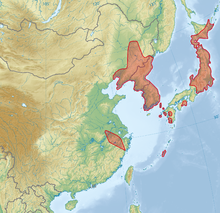
The rose-ringed parakeet, also known as the ringneck parrot or the Kramer parrot, is a medium-sized parrot in the genus Psittacula, of the family Psittacidae. It has disjunct native ranges in Africa and the Indian Subcontinent, and is now introduced into many other parts of the world where feral populations have established themselves and are bred for the exotic pet trade.

The greater noctule bat is a rare carnivorous bat found in Europe, West Asia, and North Africa. It is the largest and least studied bat in Europe with a wingspan of up to 46 centimetres (18 in) and is one of the few bat species to feed on passerine birds. Greater noctule bats are the only bat species to hunt birds on the wing rather than when roosting. The greater noctule bat has wings adapted for open-air hunting and uses echolocation frequencies above the hearing range of birds.

The Korean hare is a species of hare native to the Korean Peninsula and adjoining parts of northeastern China. The Korean hare inhabits diverse habitats within its range, from remote mountain forests to cultivated land. Fur colour varies slightly among individuals, but is generally some shade of liver brown.

The Asian parti-colored bat is a species of parti-coloured bat. An adult Asian parti-colored bat has a body length of 6–7 cm (2.4–2.8 in), a tail of 4.3–4.5 cm (1.7–1.8 in), and a wing length of 5 cm (2.0 in). Asian parti-colored bats are distributed across East Asia, from Taiwan through eastern China, eastern Mongolia and Russia (Siberia) to the Korean Peninsula and Japan.

The Japanese house bat or Japanese pipistrelle is a species of vesper bat. An adult has a body length of 3.6–4.8 cm (1.4–1.9 in), a tail of 2.9–4.0 cm (1.1–1.6 in), and a wing length of 3.2–3.6 cm (1.3–1.4 in). It prefers to roost under the ceiling or inside the roof of old buildings. It is found across East Asia, from China and Taiwan into the Ussuri region, the Korean Peninsula, and Japan.

The eastern long-fingered bat, or big-footed myotis is a species of vesper bat found in China, Japan, North Korea, South Korea, and Russia. Roosting in caves and rock crevices during the day, it forages at night for insects near rivers and streams.

The Daurian redstart is a small passerine bird from temperate Asia. The species was first described by Peter Simon Pallas in 1776.

The lesser noctule, Leisler's bat or the Irish bat, is a species of insectivorous bat belonging to the vesper bat family, Vespertilionidae. The species was named to honour the naturalist Johann Philipp Achilles Leisler.

The Azores noctule is a species of bat found in the dry forests of the Azores. It is the only species of mammal endemic to the Azores. It has been recorded on most of the islands of the Azores, and remains common on some but is rare on others. Its numbers are threatened due to habitat loss caused by humans, and the remaining populations are quite fragmented. It is known to roost in hollowed-out trees, buildings, and caves.
The mountain noctule is a species of bat found in Afghanistan, India, Pakistan, and Nepal.

The common noctule is a species of insectivorous bat common throughout Europe, Asia, and North Africa.

Rüppell's bat, also known as Rüppell's pipistrelle, is a species of vesper bat found in Africa and Asian republics such as Iraq and Israel. It is the only member of the genus Vansonia. It is found in dry and moist savanna, subtropical or tropical dry shrubland, and hot deserts.

The Ussuri tube-nosed bat is a species of vesper bat in the family Vespertilionidae. It is threatened by habitat loss. It is the only species of bat that hibernates in snowbanks.

The Vespertilioninae are a subfamily of vesper bats from the family Vespertilionidae.

Nyctalus is a genus of vespertilionid bats commonly known as the noctule bats. They are distributed in the temperate and subtropical areas of Europe, Asia and North Africa.

The Chinese noctule is a common and widespread species of bat belonging to the family Vespertilionidae.
The Japanese noctule is a species of bat belonging to the family Vespertilionidae. It is endemic to Japan.
The East Asian free-tailed bat was formerly considered to belong to the same species as the European free-tailed bat. Its range includes China, Japan, and the Korean Peninsula.
The Alashanian pipistrelle is a species of bat in the family Vespertilionidae. It is found in China, South Korea, Mongolia, Japan, and Russia.

Pipistrellini is a tribe of bats in the family Vespertilionidae. It contains several genera found throughout the Old World and Australasia, including the pipistrelles, noctules and related species.

















